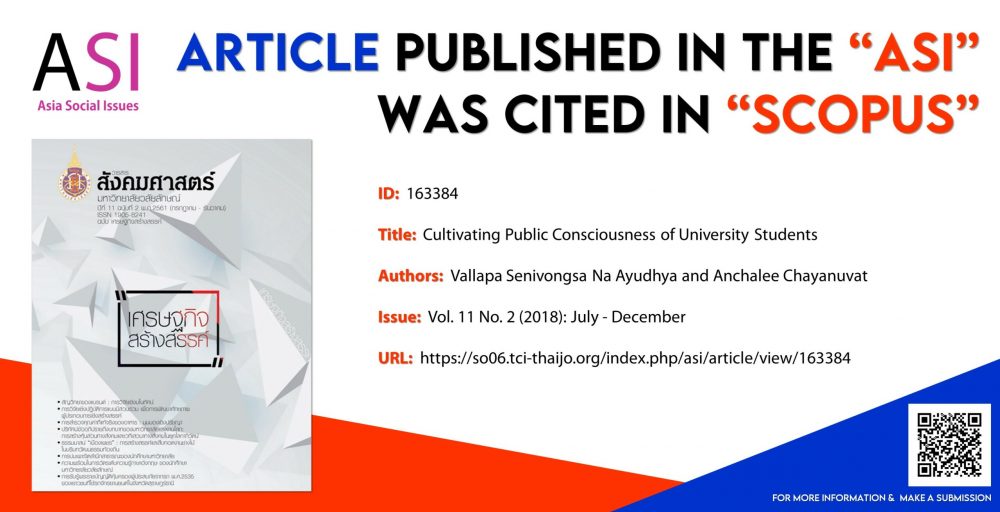- (+66) 0 7547 6481 - 6 Fax: (+66) 0 7547 6480
- grad.walailak@gmail.com
- Mon - Fri: 8:30 - 16:30

The “𝗔𝘀𝗶𝗮 𝗦𝗼𝗰𝗶𝗮𝗹 𝗜𝘀𝘀𝘂𝗲𝘀” (formerly known as Walailak Journal of Social Science), Editorial Team has selected an article that was cited in “𝗦𝗰𝗼𝗽𝘂𝘀”
𝗜𝗗: 163384
𝗧𝗜𝗧𝗟𝗘: Cultivating Public Consciousness of University Students
𝗔𝗨𝗧𝗛𝗢𝗥𝗦: Vallapa Senivongsa Na Ayudhya and Anchalee Chayanuvat
𝗜𝗦𝗦𝗨𝗘: Vol. 11 No. 2 (2018): July – December
𝗦𝗢𝗨𝗥𝗖𝗘: https://so06.tci-thaijo.org/index…/asi/article/view/163384
Abstract
Public consciousness is a valuable concept, useful for youth development. It is a key component of good citizenship. The purposes of the study are to investigate the characteristics and the public consciousness cultivating process of university students and to propose a data-driven theory of major factors in public consciousness cultivation. The study was designed as a case-based qualitative research with the Grounded Theory for data analysis. The data was collected using the semi-structured interviews of 9 students and 3 administrators and lecturers at a private university in Prathumthani, screened with purposive selection focusing on network or snowball technique. Data collection ended when the data reached theoretical saturation. Data were analyzed by using translation and interpretation. Then, the concepts were created based on theoretical sensitivity. The findings showed that cultivating public consciousness of university students consisted of six factors: meaning making and significance of public consciousness, format of the activities, the initial attraction of public consciousness, the learning outcomes, the spiritual values obtained, and supporting factors and obstacles against public consciousness cultivation. The administrators and lecturers’ views on public conscious cultivation consisted of three main factors: meaning making and significance of public consciousness, the cultivated essence, and supporting factors and obstacles against public consciousness cultivation. When the analyzed themes from the interviewed students and those of administrators and lecturers were matched, four significant factors were identified: the self, the process of public consciousness cultivation, supporting factors and obstacles against public consciousness cultivation, and the spiritual values obtained, which is the most important element for sustainability of public consciousness in students. Suggestions of this study are that the university should have a clear policy in developing student learning and public consciousness in the courses offered. Learning outside class to learn from experiences in real situations as well as cultivating public consciousness through information technology with digital gadgets and social media applications that can be done anytime and anywhere should be promoted.
𝗙𝗢𝗥 𝗠𝗢𝗥𝗘 𝗜𝗡𝗙𝗢𝗥𝗠𝗔𝗧𝗜𝗢𝗡 & 𝗠𝗔𝗞𝗘 𝗔 𝗦𝗨𝗕𝗠𝗜𝗦𝗦𝗜𝗢𝗡:
https://so06.tci-thaijo.org/index.php/asi/about/submissions
#AsiaSocialIssues
#ASI
#WalailakJournalofSocialScience
#WJSS
#Scopus
#CollegeofGraduateStudies
#CGS
#WalailakUniversity
#WU
https://grad.wu.ac.th
https://www.wu.ac.th
https://www.facebook.com/gradwalailak/
